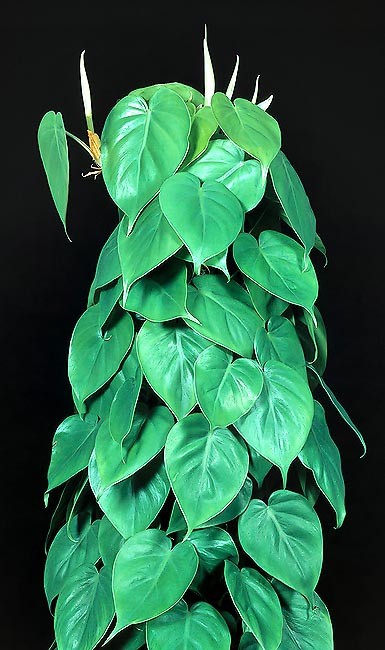Family : Araceae

Text © Pietro Puccio

English translation by Mario Beltramini

Easy and fast growing, even indoor © Giuseppe Mazza
The Philodendron hederaceum (Jacq.) Schott (1829) is native to the humid forests of North America (Mexico), Central America (Belize, Costa Rica, El Salvador, Guatemala, Honduras, Nicaragua and Panama), South America (Bolivia, Brazil, Colombia, Ecuador, French Guyana, Guyana, Peru, Surinam and Venezuela), and the Caribbean (Antigua and Barbuda, Cuba, Dominica, Guadalupe, Hispaniola, Jamaica, Martinique, Montserrat, Puerto Rico, St. Kitts and Nevis, St. Vincent and the Grenadines, Trinidad and Tobago).
The name of the genus is the combination of the Greek words “philos” = friend, and “déndron” = tree, with reference to the fact that usually the plants belonging to this genus climb on the trees; the Latin name of the species, “hederaceum” = ivy-like, refers to its climbing appearance.
Common names: “heart-leaf ivy”, “heart leaf philodendron”, “philodendron”, “sweetheart plant” (English); “philodendron grimpant” (French); “filodendro-cordato”,”filodendro-pendente”, “hera de sala” (Portuguese); “filodendro de hoja acorazonada” (Spanish); “Kletternder Philodendron” (German).
Climbing evergreen herbaceous, hemiepiphytic, with stems of 1-3 cm of diameter, rooting at the nodes, which presents the phenomenon of the heterophillia (presence of the same plant of differently shaped leaves), when the plant develops at the soil level, it presents ovate-cordate leaves with a sharp apex, long about 12 cm and 10 cm broad, of dark green, at times semi-glossy colour, as soon as it finds a support, trees or rocks where to climb, clinging with the aerial roots, the leaves become bigger and bigger, rather coriaceous, reaching the 40 cm of length and more of breadth, and when at this stage, the plant enters the reproduction phase.
The axillar inflorescences, single, erect or hanging, are formed by a spadix long up to 18 cm, surrounded by a leathery spathe, bulbous at the base, long up to 20 cm, of a green or greenish yellow colour, tending to become reddish, at times, in the inner part. The flowers are protogynous unisexual (the female flowers are receptive before the ripening of the male ones, thus avoiding self-fertilization), in particular, the male ones occupy the upper part of the spadix, for about 10 cm of length, the female ones are grouped in the lower part, for about 5 cm of length, separated by the male by a thin sterile zone; the male zone of the spadix is of cream-white or pink colour, the female one is whitish green. The fruits are berries, orange when ripe, about 1 cm long, containing 4-6 oblong whitish seeds, 3-5 mm long.
It easily reproduces by air layering and by portions of stem, with 2-3 knots, which easily root also in water, where the plant can remain and grow up for long time. The plant can be cultivated in open spaces in the tropical and humid subtropical regions, where it is often utilized in shaded locations for covering the soil or rocks and walls, on which it adheres with its aerial roots.
When in pot, it’s one of the most cultivated indoor plants, thanks to its adaptability, facility of cultivation and speed of growth, it bears for long time poorly luminous situations, even if a high luminosity, but for from the direct sun, helps in forming a luxuriant vegetation. It needs very porous substrata, draining and rich of organic substance and temperatures over the 14-16°C, best if around 20-22°C, and can be utilized as hanging or can be placed, as a climber, on supports covered by bog moss or synthetic material capable to retain the humidity. Watering must be more frequent in summer, less in winter, always avoiding water stagnations which can cause rottenness.
All the parts of the plant contain toxic substances, in particular calcium oxalate, which can cause atopic dermatitis, and reactions, even serious, if chewed and swallowed.
Synonyms: Arum hederaceum Jacq. (1760); Pothos hederaceus (Jacq.) Aubl. (1775); Philodendron prieurianum Schott (1853); Philodendron scandens K.Koch & Sello (1853); Philodendron cuspidatum K.Koch & C.D.Bouché (1855); Philodendron micans Klotzsch ex K.Koch (1855); Philodendron microphyllum K.Koch (1855); Philodendron oxyprorum Schott (1856); Philodendron acrocardium Schott (1858); Philodendron isertianum Schott (1860); Philodendron scaberulum C.Wright (1870); Philodendron micans var. brevipes Engl. (1899); Philodendron micans var. microphyllum (K.Koch) Engl. (1899); Philodendron pittieri Engl. (1899); Philodendron scandens var. cubense Engl. (1899); Philodendron scandens var. cuspidatum (K.Koch & C.D.Bouché) Engl. (1899); Philodendron subsessile Gleason (1929); Philodendron harlowii I.M.Johnst. (1949); Philodendron miduhoi Matuda (1950); Philodendron scandens subsp. isertianum (Schott) G.S.Bunting (1968); Philodendron scandens f. micans (Klotzsch ex K.Koch) G.S.Bunting (1968); Philodendron scandens subsp. prieurianum (Schott) G.S.Bunting (1968); Philodendron scandens subsp. cubense (Engl.) I.Arias (1998).
